Submitted:
17 September 2024
Posted:
18 September 2024
Read the latest preprint version here
Abstract
Keywords:
1. Introduction
2. Dirac Fermion within the Confinement of a MP Model
2a. Unveiling Both Dirac Belt Trick and CPT Symmetry
2b. Quantum Mechanics and Dirac Notations
- The electron of wave-particle duality obeys de Broglie relationship, with h assigned to its sinusoidal orbit and mv to BO. It is defined by the wave function, and its orbit of time reversal adheres to the Schrödinger equation, and is fundamental aspect of the MP model (Figure 1c) in accordance with Equation (1) (see also Appendix A for further explanations). Electron spin-charge states of superposition from electron-positron transition is linked to BO defined by with its inner product, . Conjugate charges at positions, 1, 3 and 5 and 7 cancels each other out at spherical lightspeed to form close loops of BO at an energy n-level, where the electron is stabilized by levitation between the hemispheres of the MP field to generate only either spin up or spin down in accordance with Pauli exclusion principle. At 360° rotation, an electron of spin up is produced and at 720° rotation, a positron of spin down is formed. The loops of BOs mimic topological torus (Figure 1d) and by disturbance these become differential manifolds into n-levels or n-dimensions with levitation assumed between the hemispheres of the MP field. In this manner, the electron forms a weak isospin of spin up and spin down into n-dimensions, whereas the z-axis resembles nuclear isospin.
- Both radial and angular wave functions are applicable to the electron, . The radial part, is attributed to the principal quantum number, n and angular momentum, l of a light-cone with respect to r (Figure 1c). The angular part, in degenerate states, with respect to the z-axis is assigned to the BO defined by both and (Figure 1d).
- The BO is defined by a constant structure, ɑ and its orthogonal (perpendicular) to z-axis by linearization (Figure 1d). Its link to electron-positron pair is, for continuous derivation of MP field precession and is relevant to Fourier transform (see also Appendix B). Linear translation for the n-levels along z-axis can relate to the sum of expansion coefficients, , where the electron’s position offers an expectant value, with its probability as, .
- The shift in the electron’s position of hermitian conjugates by Dirac process, P(0→8) = assumes Hamiltonian space with by precession. The complete spherical rotation towards the point-boundary for the polarization states, 0, 1 assumes U(1) symmetry and incorporates Euler’s formula, + 1 = 0 in real space (Figure 1c).
- Singularity at Planck’s length is assigned to the point-boundary at position 0 and this promotes radiation of the type, from the electron-positron transition. Somehow it sustains the principal axis of the MP field as z-axis or nuclear isospin in asymmetry and promotes ±h at spherical lightspeed. The point towards the center is linked to a light-cone that levitates between two hemispheres similar to Weyl spinor (e.g., Figure 1b). Its accessibility is restricted both by levitation and electron orbit at positions 2 and 6.
2c. Visualization of 2D Manifolds into 4D Space-Time
2d. Center of Mass Reference Frame and Its Dynamics
3. Some Basic Components of both QM and QFT
- ⇒
- Dirac theory and helical property. The fermion field is defined by the famous Dirac equation of the generic form,where are gamma matrices. The exponentials of the matrices, are attributed to the electron’s position by clockwise precession acting on its time reversal orbit. For example, is assigned to the vertex of the MP field and by electron-positron transition at position 0, it sustains z-axis as arrow of time in asymmetry. Thus, arrow of time for a pair of vertices for spin up and spin down incorporates time reversal symmetry. The variables of Dirac matrices are assumed by the electron shift in its positions (Figure 2a–f). Orthogonal projections of the space-time variables, are confined to a hemisphere and assigned to a light-cone to generate spin-charge of the electron (e.g., Figure 1c). These descriptions uphold CPT symmetry and are indirectly incorporated into the famous Dirac equation,where c acts on the coefficients A, B and C and transforms them to and . The exponentials of are denoted i for off-diagonal Pauli matrices for the light-cone (Figure 1d) and is defined by,and zero exponential, is,The qubits 0 and 1 are assigned to the COM at positions 0 and 8, and hypercharge –1 to position 4 (e.g., Figure 1a). Such a notion can become relevant to classical computing, whereas quantum computing for nucleons mimicking the MP model is subjected to quantum chaos of butterfly effect assigned to envelop solitons at either position 2 or 6 encasing quantum critical point of the light-cone (see also subsection 2d). is assigned to oscillations from on-shell momentum of the BOs into n-dimensions (Figure 1d) for anticommutation relationship, of chiral symmetry (Figure 2c,d). The associated vector gauge invariance for the electron-positron transition exhibits the following relationships,andThe exponential factor, iθ refers to the position, i of the electron of a complex number and θ, is its angular momentum (e.g., Figure 1c). The unitary rotations of right-handedness (R) or positive helicity and left-handedness (L) or negative helicity are applicable to the electron transformation to Dirac fermion (e.g., Figure 2A in Appendix B). The process is confined to a hemisphere and this equates to spin-1/2 property of a complex spinor. Two successive rotations of the electron in orbit by clockwise precession of the MP field is identified by . The chirality or vector axial current at the point-boundary is assigned to polarized states, ±1 of the model (Figure 1c). The helical symmetry from projections operators or nuclear isospin of z-axis acting on the spinors (Figure 2e) is,andwhere is likened to thermal radiation of a black body. The usual properties of projection operators are: L + R = 1; RL = LR = 0; L2 = L and R2 = R (e.g., Figure 2a–d) consistent with CPT symmetry.
- ⇒
- Wave function collapse. Dirac fermion or spinor is denoted ψ(x) in 3D Euclidean space and it is superimposed onto the MP model of 4D space-time, ψ(x,t) by clockwise precession (Figure 3a). The latter resembles Minkowski space-time and consists of a light- cone dissected by z-axis as arrow of time into asymmetry (Figure 1b). The former includes both positive and negative curvatures of non-Euclidean space (e.g., Figure 2a,b) normalized to straight paths of Euclidean space (Figure 2c,d). These are of non-abelian Lie group (see subsection 2c) imposed on the surface of the spherical MP model somewhat mimicking Poincaré sphere. The Dirac four-component spinor, is attributed to positions 0 to 3 of conjugate pairs in 3D space. Convergence of positions 1 and 3 at either position 0 or 2 is relevant to the equivalence principle based on general relativity for Euclidean geometry (Figure 3a). The quantum aspect of de Sitter space by geodetic clockwise precession is balanced out by anti-de Sitter form of the electron transition in its orbit of time reversal due to gravity. For the irreducible spinor represented by the MP model, gravity is assigned to a gyroscopic geometry. Any light paths tangential to BOs of n-energy levels interacting with the electron is expected to mimic Fourier transform along z-axis of the MP field as time axis in asymmetry and this is equivalent to wave function collapse (Figure 3b). Constraining the electron’s position offers the uncertainty principle with on-shell momentum of BO susceptible to levitation between the two hemispheres of the MP field. The generated wave amplitudes of BOs can relate to a typical hydrogen emission spectrum (Figure 3c), where wave function collapse of probabilistic distribution by Born’s rule,, is relatable to the hemispheres.
- ⇒
- Quantized Hamiltonian. Two ansatzes adapted from Equation (14) are given by,andwhere outward projection of electron spin at positions 5, 7 is represented by and inward projection at positions 1, 3 by (e.g., Figure 2c,d). By linear transformation, the hermitian plane wave solutions form the basis for Fourier components in 3D space (Figure 1d and Figure 3b). Decomposition of quantized Hamiltonian ensues as,where the constant, is attributed to the dissection of BOs along z-axis. Its conjugate form is by,The coefficients and are ladder operators for u-type spinor and and for v-type spinor at n-dimensions of BOs mimicking topological torus with levitation assumed between the hemispheres of the MP model (e.g., Figure 1d). These are related to Dirac spinors of two spin states, ±1/2 with and as their antiparticles. Dirac Hamiltonian of one-particle quantum mechanics relevant to the MP model of hydrogen atom type is,The quantity in the bracket is provided in Equation (3). By parity transformation, the observable and holographic oscillators are canonically conjugates (e.g., Figure 2c,d). The associated momentum is,With z-axis of the MP field assuming time axis in asymmetry (Figure 1c), V-A currents are projected in either x or y directions in 3D space comparable to Fourier transform (e.g., Figure 3b). These assume the relationships,and its matrix form,where α and β denote the spinor components of . Equations (23a) refers to unitarity of the model and Equation (23b) is assumed by the electron-positron transition about the manifolds of BOs in 3D space (Figure 1d). The independent of time in 3D space obeys the uncertainty principle with respect to the electron’s position, p and momentum, q, as conjugate operators (Figure 1c). The commutation relationship of p and q is,Equation (24) incorporates both matter and antimatter and their translation to linear time (Figure 3b). The electron as a physical entity generates a positive-frequency such as,Equation (25) could explain the dominance of matter (electron) over antimatter based on the conceptualization process of Dirac fermion (e.g., Figure 2a,b).
- ⇒
-
Non-relativistic wave function. Observation by light-matter interaction allows for the emergence of the model from the point-boundary at Planck length. Subsequent energy shells of BOs at the n-levels by excitation accommodates complex fermions, ±1/2, ±3/2, ±5/2 and so forth (Figure 4a). The orbitals of 3D are defined by total angular momentum, and this incorporates both orbital angular momentum, l and spin angular momentum, s (Figure 4b). These are aligned with Schrödinger wave function (e.g., Figure 1c).The reader is also referred to . Within a hemisphere, the model is transformed to a classical oscillator. By clockwise precession, a holographic oscillator from the other hemisphere of the MP field remains hidden. One oscillator levitates about the other (Figure 4b) and both are not simultaneously accessible to observation by Fourier transform (e.g., Figure 3b). Levitation of on-shell momentum of BO into n-levels between the hemispheres of the MP model can be pursued for Fermi-Dirac statistics if these equate to fermion type particles. The point-boundary at the vertex of MP field at position 0 of COM is assigned to ZPE and both vertices constrain vacuum energy with its perturbation by precession. The splitting (Figure 4a) applies to Landé interval rule for the electron of weak isospin and this can somehow relate to lamb shift based on the subshells of BOs into n-dimensions by levitation between the hemispheres of the spherical model (e.g., Figure 1d). Such a scenario is similar to how vibrational spectra of a harmonic oscillator for diatoms like hydrogen molecule incorporates rotational energy levels (Figure 4a). The difference of the classical oscillator to the quantum scale is the application of Schrödinger wave equation (e.g., Figure 1c).
- ⇒
- Weyl spinor. The light-cone within a hemisphere accommodates both matter and antimatter by parity transformation (Figure 4a,b). It is described in the form,Equation (26) corresponds to spin up fermion, a spin down fermion, a spin up antifermion and a spin down antifermion (e.g., Figure 2c,d). By forming its own antimatter, Dirac fermion somewhat resembles Majorana fermions. It is difficult to observe them simultaneously due to wave function collapse restricted to light-particle interaction into linear time (e.g., Figure 3b). Non-relativistic Weyl spinor of a pair of light-cones in 4D by levitation between the hemispheres of the precessing MP field of clockwise direction is relevant to the fundamental Schrödinger wave equation (Figure 1c and Figure 1A in Appendix A). These are defined by reduction of Equation (26) to a bispinor in the form,where are Weyl spinors of chirality with respect to the electron position in orbit. By parity operation, x → x’ = (t, ‒ x), qubits 1 and −1 are generated at the vertices of the MP field (e.g., Figure 1c). Depending on the reference point-boundary of the BO (Figure 1d), the exchanges of left- and right-handed Weyl spinor assumed the process,Conversion of Weyl spinors to Dirac bispinor, are of transposition state (e.g., Figure 2c,d)). The two-component spinor, = 1 are normalized at the point-boundary at position 0 of the spherical model (Figure 1a).
- ⇒
- Lorentz transformation. The Hermitian pair, of Dirac fermion based on Equation (27) undergo Lorentz boost and translate the BOs into n-levels (Figure 1d) of the form,The corresponding Lorentz scalar applicable to scattering from on-shell momentum tangential to the BOs (Figure 1d) is,Equation (30) is referenced to z-axis of the MP field as time axis and is relevant to Fourier transform into linear time. By identical calculation to Equation (29), the Weyl spinor is,Both Weyl spinor of a light-cone (Figure 4a) and Majorana fermion are indistinguishable from Dirac spinor for light-matter interaction confined to position 0 (e.g., Figure 1a).
- ⇒
- Electroweak symmetry breaking mechanism. If the electron as a physical entity is ejected by ionization, a particle-hole is generated at the positions 0 to 8 by assuming conservation of the MP model (Figure 1a). The electron or its particle-hole is of chiral symmetry for the model, where CPT symmetry is described by charge conjugation from electron-positron pairing, parity inversion for electron-positron transition within interchangeable pair of hemispheres (Figure 2c,d), and time reversal to electron orbit of the elliptical MP field. When the MP field is subjected to clockwise precession at spherical lightspeed, the electron is transformed to Dirac fermion by Dirac belt trick (Figure 1a). At high energy, the infinite n-dimensions of conjugate positions, 1, 3 and 5, 7 for BO of topological torus (Figure 1d) and their levitation between two hemispheres of the MP field (Figure 4a,b) is reduced linearly along positions 2 and 6. This coincides with the correspondence principle for non-dimensional system, with the natural units set, . The emergence of COM at the vertices of the MP field from the separation of the pair of hemispheres somehow can relate Higgs-like boson, . The COM is incorporated in the first term of the Higgs field scalar quantity, . The second term is applicable to positions 1, 3 or 5, 7 and both are relevant to the emergence of bosons for the measureable quantity, about horizontal x-axis of the Mexican hat potential. The y-axis consists of imaginary potential, and the emergence of the z-axis of the MP field as time axis in asymmetry for neutral current can be assigned to boson. These descriptions are compatible to Feynman diagrams for the coupling of ionized MP models mimicking proton-proton collisions (Figure 5a,b). The neutrino types (e.g., ) of helical property would mimic the electron-positron transition of flipped hypercharge by Dirac belt trick and are attributed to trivial shift in z-axis, by precession (Figure 1d) towards positions 1 and 3 linked to bosons. From on-shell momentum (), particles acquire energy, or such as for massive photons by Einstein mass-energy equivalence of the form,Based on Equation (32), light and particle-hole coupling from the emergence of the MP field amplitudes from non-dimensional linear setting at at high energy is expected to translate positions 1 and 3 to mimic bosons. These are massive and about 80 times the mass of proton. The particle-hole shift to positions 2 and 6 forms envelope solitons and restricts observation of quarks at the center by allowing the development of asymptotic freedom. Levitation of BOs into n-dimensions is linked to the pair of light-cones between the two hemispheres of the MP field. These can translate to leptons such as tau, muon and their antimatter. Tangential light paths along z-axis can relate to boson of neutral current and COM at position 0 to . In this way, beta decays of to and or similarly, to and can be accounted by MP models coupling. How bosons are linked to the conversion of neutron to proton such as for beta decay is not covered here but it is posited here that the quark model could resemble the MP model, and both are linked by the z-axis as arrow of time in asymmetry akin to nuclear isospin. These explanations appear consistent to lack of supersymmetry observed in high energy experiments and the dilemma associated with baryon asymmetry. Such a prospect is explored further in a subsequent study by the author.
4. Conclusion
Data Availability Statement
Conflicts of Interest
Appendix A. Mathematical Property of Schrödinger Wave Equation
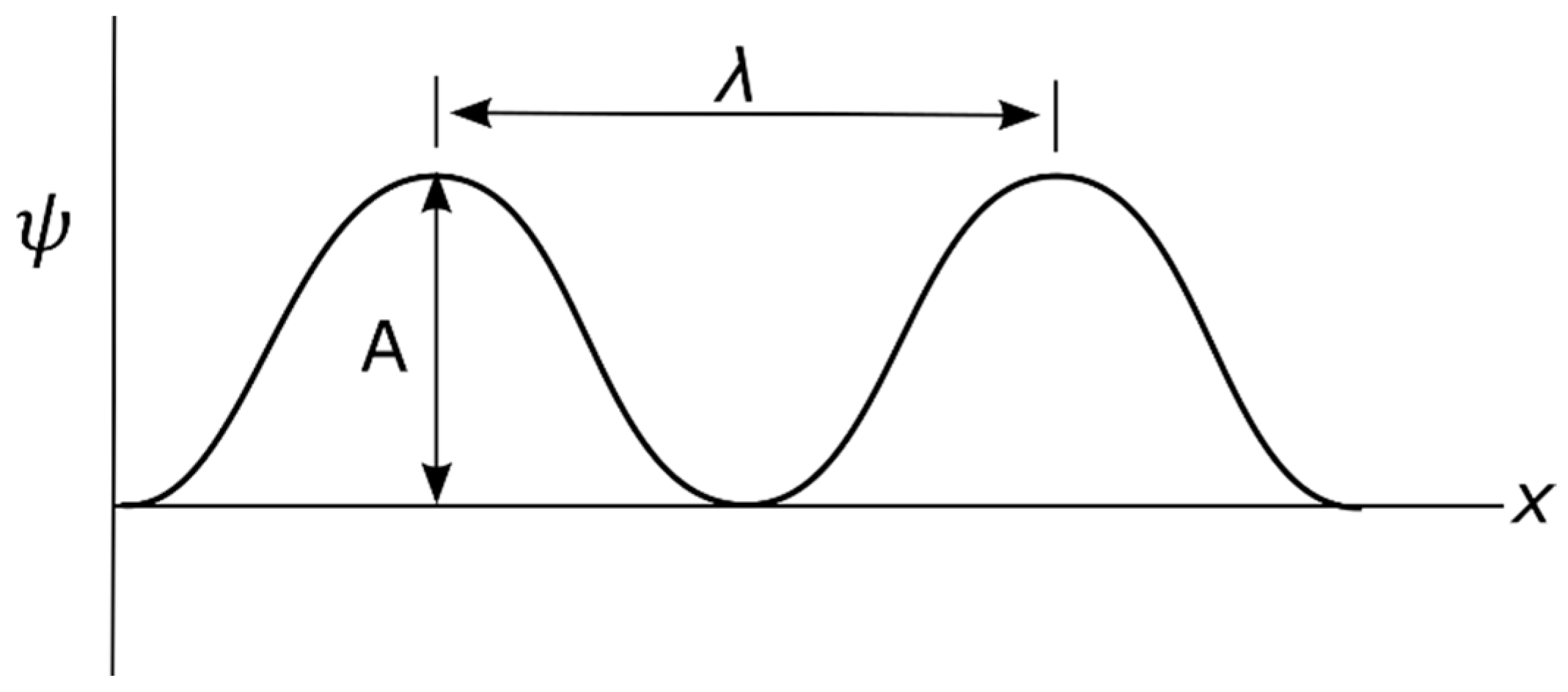
Appendix B. Basis of Vectors, Matrices, Tensors and Fourier Transform
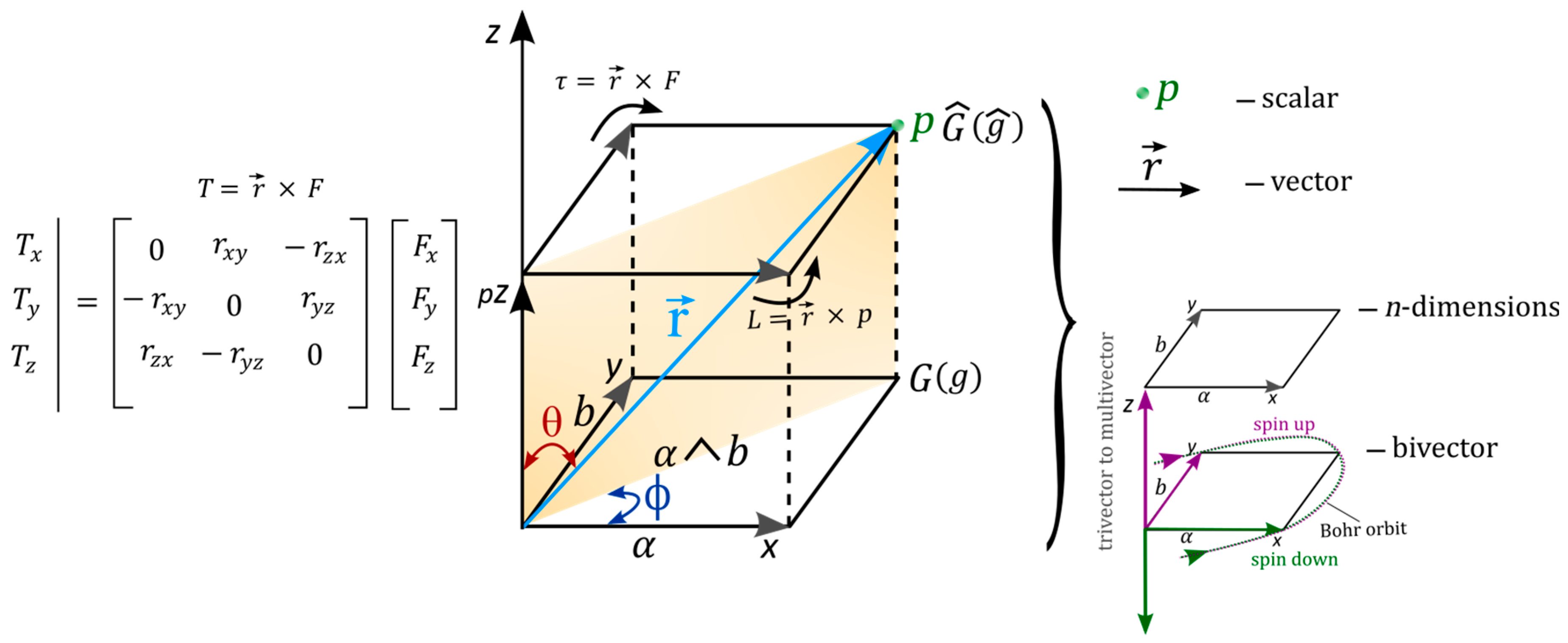
Appendix C. Vector Modelling of the MP Model
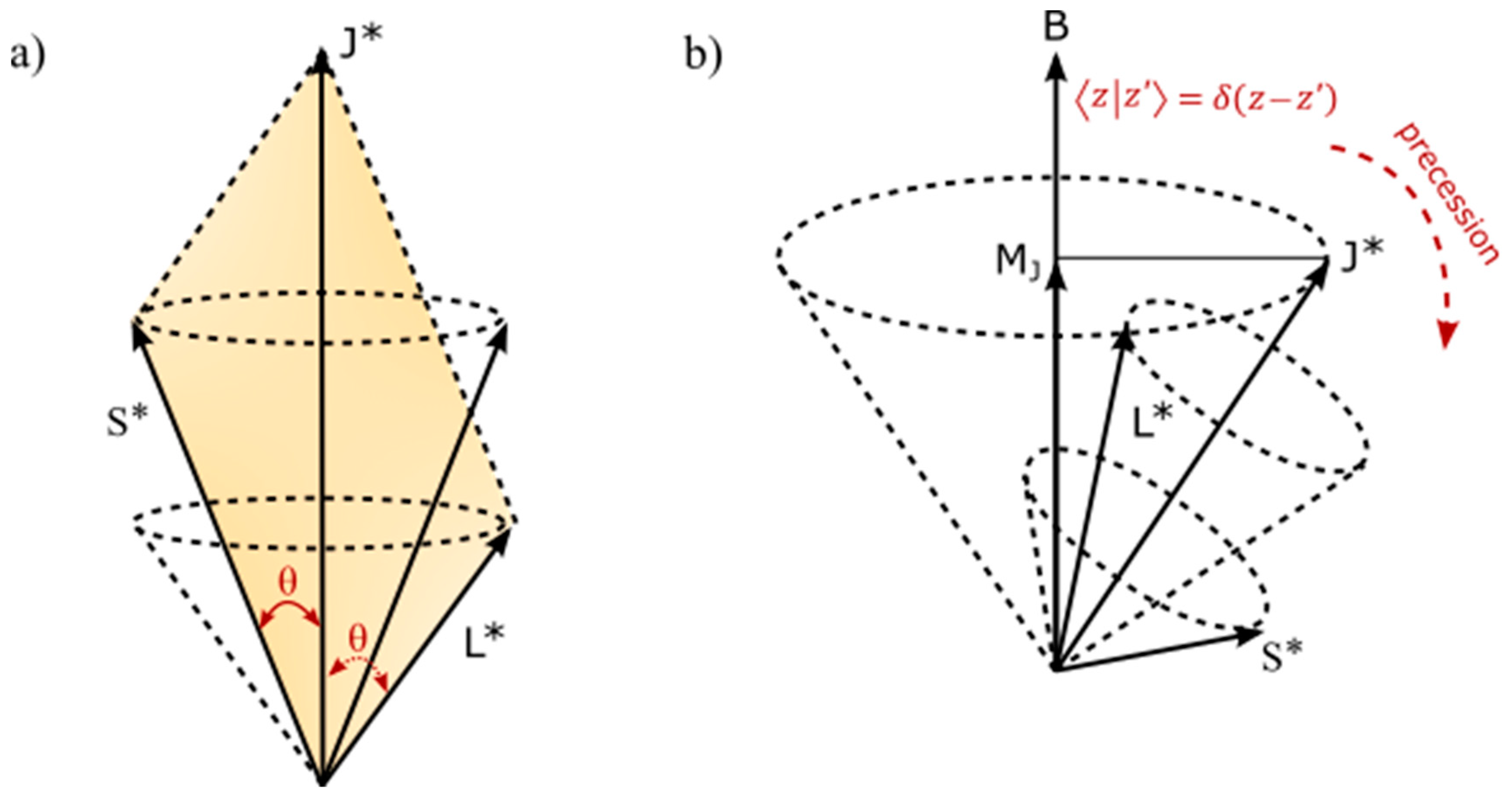
References
- Nelson, E. Derivation of the Schrödinger equation from Newtonian mechanics. Phys. Rev. 150(4), 1079 (1966). [CrossRef]
- Li, Z. Y. Elementary analysis of interferometers for wave—particle duality test and the prospect of going beyond the complementarity principle. Chin. Phys. B 23(11), 110309 (2014). [CrossRef]
- Rabinowitz, M. Examination of wave-particle duality via two-slit interference. Mod. Phys. Lett. B 9(13), 763-789 (1995). [CrossRef]
- Pawłowski, M. et al. Information causality as a physical principle. Nature 461(7267), 1101-1104 (2009). [CrossRef]
- Henson, J. Comparing causality principles. Stud. Hist. Philos M. P, 36(3), 519-543 (2005). [CrossRef]
- Rovelli, C. Space is blue and birds fly through it. Philos. Trans. Royal Soc. Proc. Math. Phys. Eng. 376(2123), 20170312 (2018). [CrossRef]
- Sun, H. Solutions of nonrelativistic Schrödinger equation from relativistic Klein–Gordon equation. Phys. Lett. A 374(2), 116-122 (2009). [CrossRef]
- Alvarez-Gaumé, L. & Vazquez-Mozo, M. A. Introductory lectures on quantum field theory. arXiv preprint hep-th/0510040 (2005).
- Weiss, L. S. et al. Controlled creation of a singular spinor vortex by circumventing the Dirac belt trick. Nat. Commun. 10(1), 1-8 (2019). [CrossRef]
- Silagadze, Z. K. Mirror objects in the solar system?. arXiv preprint astro-ph/0110161 (2001).
- Rieflin, E. Some mechanisms related to Dirac’s strings. Am. J. Phys. 47(4), 379-380 (1979).
- Oshima, S., Kanemaki, S. & Fujita, T. Problems of Real Scalar Klein-Gordon Field. arXiv preprint hep-th/0512156 (2005).
- Yuguru, S. P. Unconventional reconciliation path for quantum mechanics and general relativity. IET Quant. Comm. 3(2), 99–111 (2022). [CrossRef]
- Jaffe. R. L. Supplementary notes on Dirac notation, quantum states, etc. https://web.mit.edu/8.05/handouts/jaffe1.pdf (September, 2007).
- Eigen, C. Spinors for beginners. https://www.youtube.com/@eigenchris (November, 2012).
- Zhelobenko, D. P. Compact Lie groups and their representations. J. Amer. Math. Soc. 40, 26-49 (1973).
- Alvarez-Gaumé, L. & Vazquez-Mozo, M. A. Introductory lectures on quantum field theory. arXiv preprint hep-th/0510040 (2005).
- Burdman, G. Quantum field theory I_Lectures. http://fma.if.usp.br/~burdman (October, 2023).
- Peskin, M. E. & Schroeder, D. V. An introduction to quantum field theory. Addison-Wesley, Massachusetts, USA (1995). pp 13–25, 40–62. [CrossRef]
- https://en.wikipedia.org/wiki/Spinor (updated February 2024).
- Das, I. et al. An introduction to physical chemistry. New Age International (P) Limited, New Delhi, India (2005) 2nd Ed. pp 16-20.
- Singh, R. B. Introduction to modern physics. New Age International (P) Limited, New Delhi, India (2009) 2nd Ed. Vol. 1, pp 420-425.
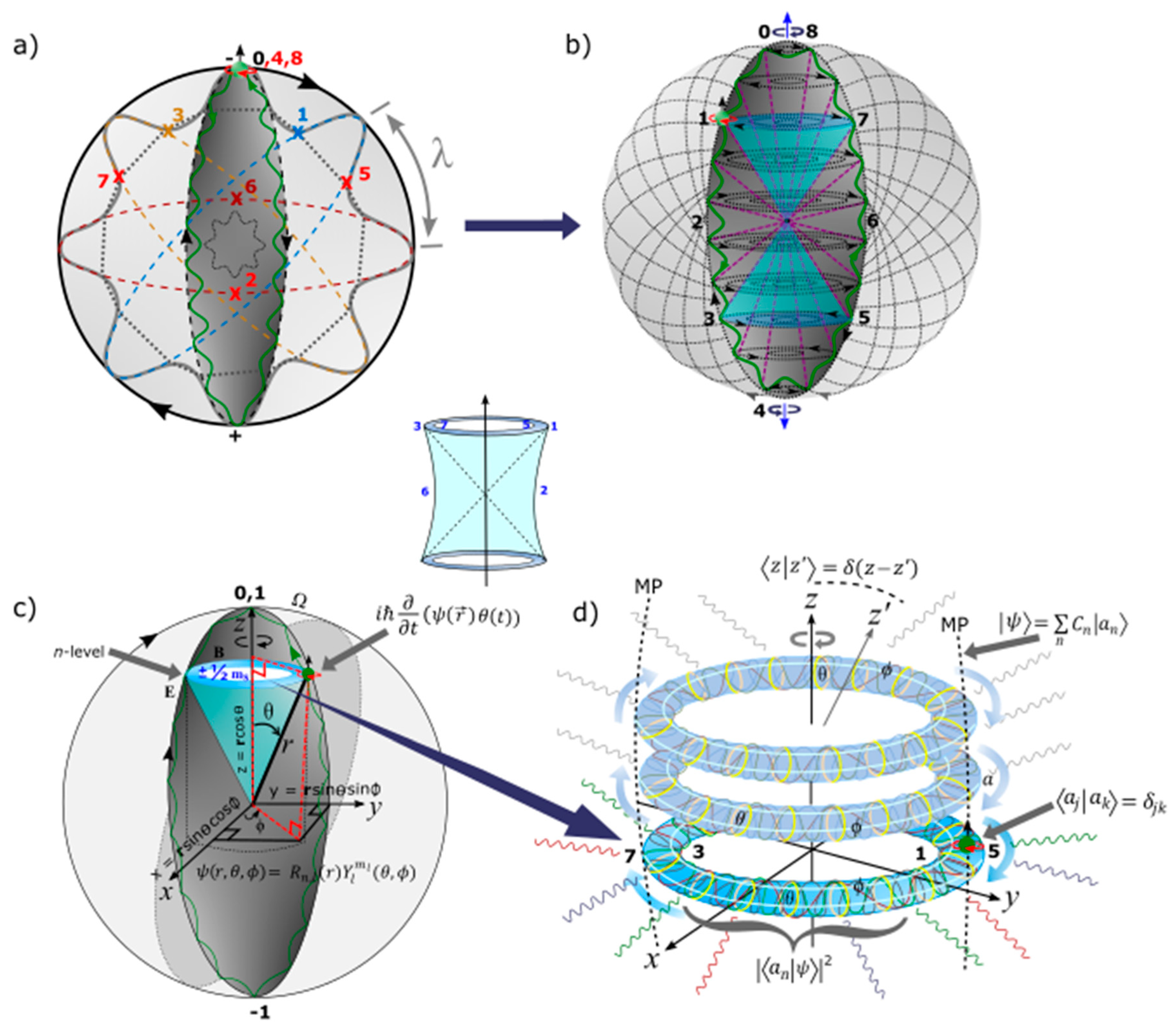
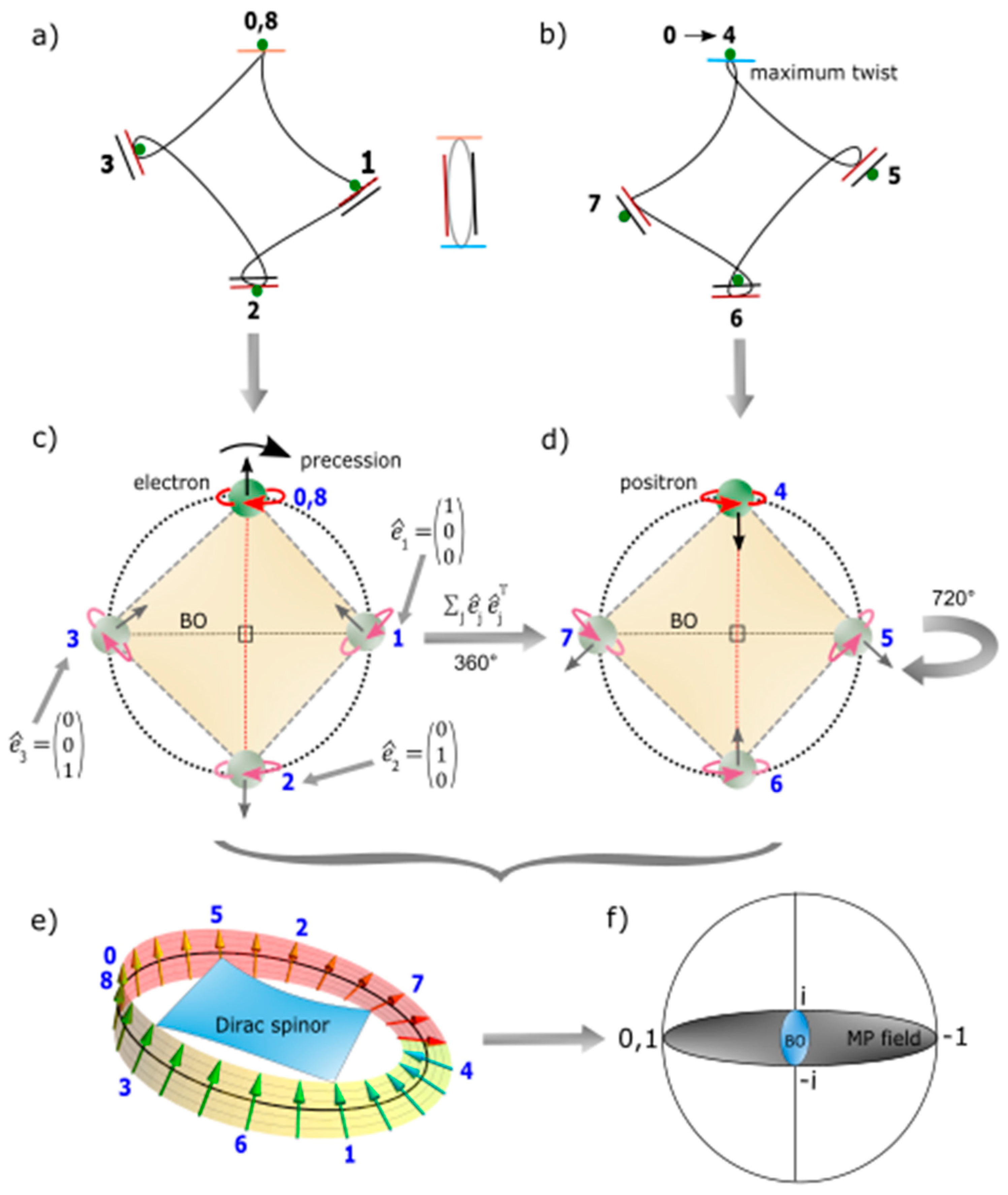
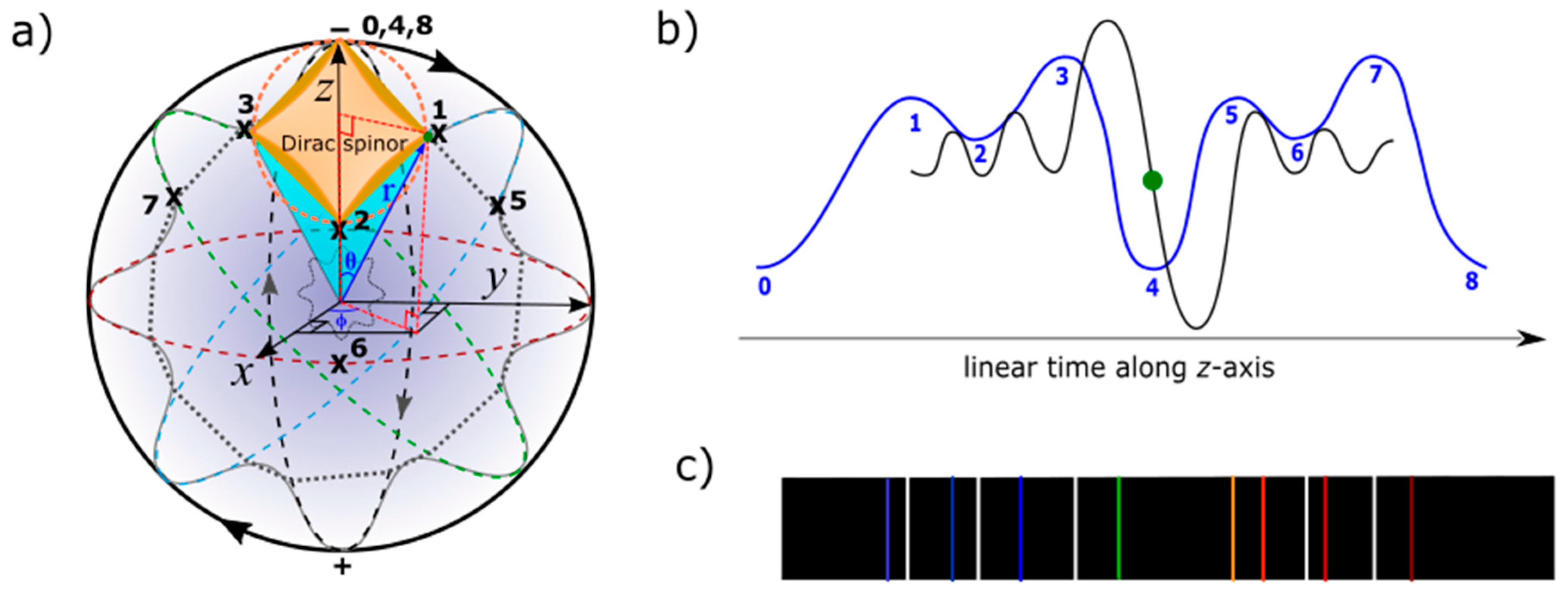
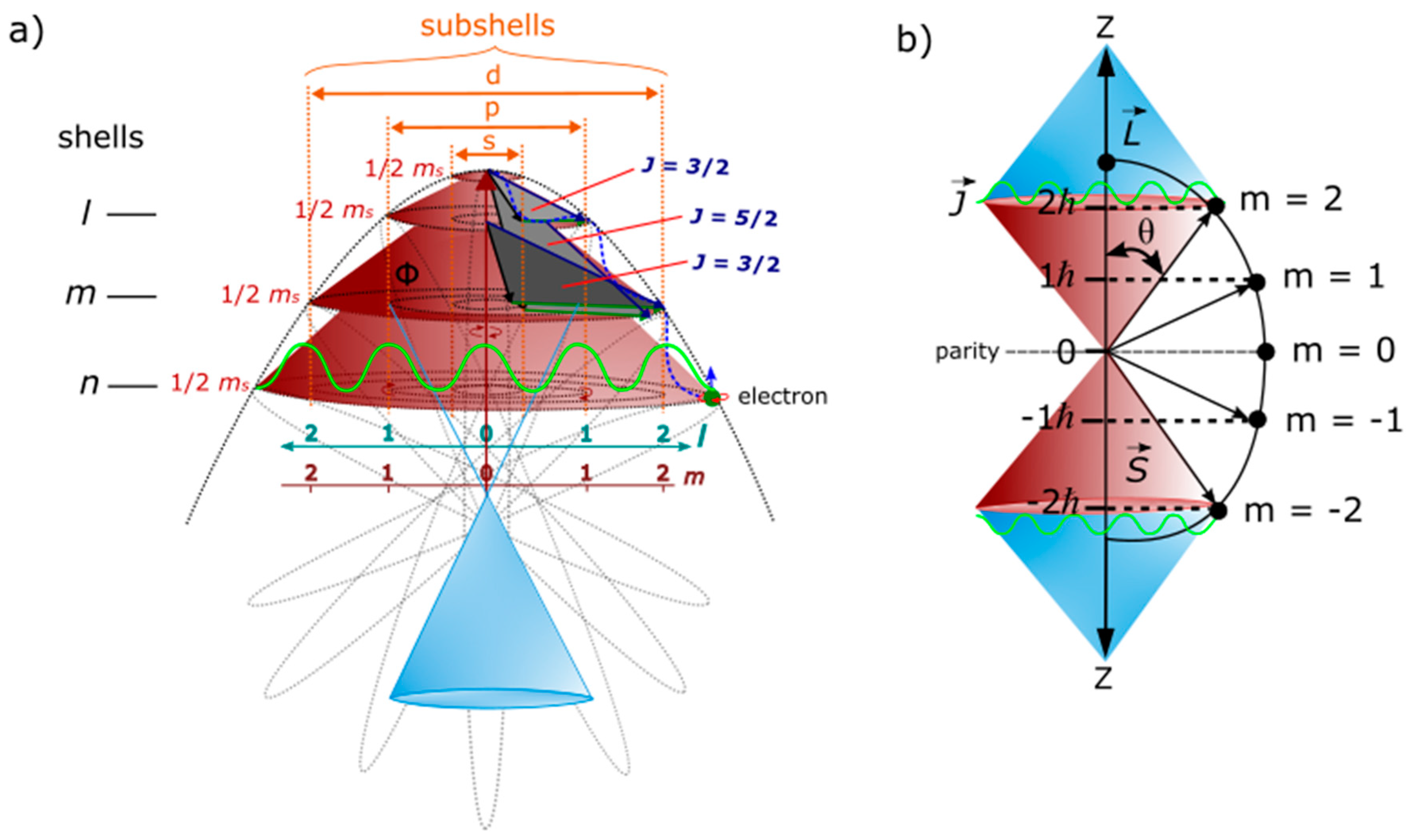

Disclaimer/Publisher’s Note: The statements, opinions and data contained in all publications are solely those of the individual author(s) and contributor(s) and not of MDPI and/or the editor(s). MDPI and/or the editor(s) disclaim responsibility for any injury to people or property resulting from any ideas, methods, instructions or products referred to in the content. |
© 2024 by the authors. Licensee MDPI, Basel, Switzerland. This article is an open access article distributed under the terms and conditions of the Creative Commons Attribution (CC BY) license (http://creativecommons.org/licenses/by/4.0/).




